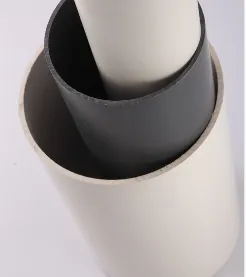Aza . 28, 2024 14:17 Itzuli zerrendara
Choosing the Right Thickness of HDPE Sheets for Heavy-Duty Applications
Selecting the appropriate thickness of HDPE sheets for specific applications, particularly in high-impact and structural environments, is essential to ensure safety, longevity, and performance. With options ranging from thin HDPE sheets to thicker ones used in construction, understanding the right HDPE sheet sizes and characteristics can make all the difference in your project.

Thin HDPE Sheet: Lightweight Yet Durable for Moderate Applications
While thin HDPE sheets might seem less robust, they offer surprising durability and flexibility, making them suitable for applications where lighter loads and easier handling are essential. For example, thin HDPE sheets work well in lining, layering, or light-duty flooring, where weight is a concern, but structural integrity is still required. Despite their reduced thickness, these sheets maintain HDPE’s excellent resistance to chemicals and impact, making them a versatile choice for environments like food processing or storage facilities.
When selecting thin HDPE sheets for your project, keep in mind that while they are lightweight, they retain HDPE’s core benefits, such as durability and water resistance. This makes them ideal for applications that need frequent repositioning or replacement without compromising on safety or quality.
HDPE Sheet for Construction: Thick and Sturdy for Structural Integrity
For more demanding environments, HDPE sheets for construction provide the strength and resilience necessary for load-bearing and high-impact applications. These thicker HDPE black sheets are ideal for construction projects where the material must withstand heavy machinery, physical pressure, and prolonged exposure to outdoor conditions. In addition to thickness, these construction-grade sheets offer added resistance to chemicals, UV light, and environmental wear, ensuring they remain intact in challenging environments.
By selecting HDPE sheets for construction, you’re investing in a material that offers superior stability and longevity. This is particularly beneficial in permanent installations or structural components where both durability and long-term performance are critical factors.
HDPE Spec Sheet: Understanding Key Features for Optimal Application
The HDPE spec sheet is an essential resource when determining the appropriate HDPE sheet thickness for your project. These specification sheets provide detailed information on characteristics like density, tensile strength, and impact resistance, helping you assess how well a particular HDPE xafla aligns with your application’s needs. Reviewing the HDPE spec sheet also allows you to compare different thicknesses and grades, ensuring that you select the sheet with the right balance of flexibility and strength.
For instance, high-impact applications may require thicker sheets with specific resilience ratings, while lighter applications can benefit from thinner sheets that offer ease of handling. Using the HDPE spec sheet as a guide allows you to match the material’s properties to the demands of the project, ensuring a safer and more effective implementation.
HDPE Sheet Sizes: Tailoring Dimensions for Your Project Requirements
HDPE sheet sizes come in a variety of dimensions, giving you flexibility in choosing the exact configuration required for your project. Standard HDPE sheet sizes are available in common industry dimensions, but custom sizes can also be ordered to fit unique installation requirements. Choosing the right sheet size minimizes material waste and ensures a smoother installation, especially in projects with precise measurements.
Whether you need large sheets for extensive coverage in flooring or smaller, more manageable pieces for partitioning and protection, selecting the right HDPE sheet sizes enhances both functionality and aesthetics. Additionally, correct sizing reduces the need for cutting or modifications, which can improve the material’s structural integrity and installation efficiency.
HDPE Black Sheet: Versatile and Visually Appealing for Diverse Applications
The HDPE xafla beltza is a popular choice in industrial and commercial settings due to its unique color and durability. Beyond aesthetics, the black coloring in these sheets often adds UV resistance, making them an excellent option for outdoor applications that demand prolonged exposure to sunlight without degrading. The HDPE xafla beltza is also a preferred choice for visible installations, such as walls, dividers, or work surfaces, where appearance is as important as function.
In addition to its practical benefits, the HDPE xafla beltza offers all the fundamental advantages of HDPE, including resistance to chemicals, impact, and environmental wear. This makes it suitable for applications ranging from construction to decorative and functional indoor uses, where durability and a professional look are paramount.
Choosing the right HDPE sheet thickness for heavy-duty applications requires a careful balance of factors, including durability, flexibility, and the specific demands of the project. From thin HDPE sheets that offer lightweight versatility to HDPE sheets for construction that ensure maximum durability, each thickness and style of HDPE serves a unique purpose. Leveraging resources like the HDPE spec sheet can further enhance your decision-making process by providing the essential data needed to match the material’s properties with your project requirements.
-
Welding Rods: The Backbone of Plastic Welding Applications
BerriakJun.06,2025
-
PVC Sheet: A Versatile Material for Modern Construction and Design
BerriakJun.06,2025
-
PVC Rod: A Reliable and Versatile Material for Industrial Applications
BerriakJun.06,2025
-
Pipe Fittings: Essential Components for Secure and Efficient Plumbing Systems
BerriakJun.06,2025
-
HDPE Sheet: Durable, Versatile, and Eco-Friendly Plastic for All Applications
BerriakJun.06,2025
-
HDPE Pipe Solutions: Durable, Versatile, and Built to Last
BerriakJun.06,2025

